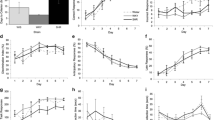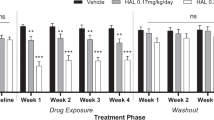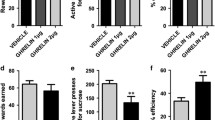Abstract
Rationale
Palatability and incentive value influence animal food choice. Dopamine D2/3 receptor signaling may mediate the effects of palatability and incentive value on choice. Dopamine signaling is disrupted in attention-deficit hyperactivity disorder (ADHD). Investigating behavioral choice processes under D2/3 receptor agonists will help elucidate behavioral and pharmacological correlates of ADHD.
Objectives
To determine (1) how changes in incentive value affects choice of actions for outcomes that differ in palatability; (2) the effects of the D2/3 agonist quinpirole on choice based on palatability and incentive value; (3) how choice differs in spontaneously hypertensive rats (SHR; ADHD model) compared with control strains.
Methods
Rats responded instrumentally for two food outcomes (chocolate and grain pellets) that differed in palatability. Following specific satiety of one outcome, rats underwent a choice test. Prior to the choice test, rats were given intra-peritoneal quinpirole (0.01–0.1 mg/kg) body weight. These manipulations were conducted in three strains of rats: SHR rats; the normotensive Wistar-Kyoto (WKY) controls; and Wistar outbred (WIS) controls.
Results
All rat strains responded more vigorously for chocolate pellets compared with grain pellets. Quinpirole reduced the effects of palatability and dose-dependently increased the effects of incentive value on choice. SHR rats were the least influenced by incentive value, whereas WKY rats were the least influenced by palatability.
Conclusions
These results show that D2/3 signaling modulates choice based on palatability and incentive value. Disruption of this process in SHR rats may mirror motivational impairments observed in ADHD.




Similar content being viewed by others
References
Adams CD, Dickinson A (1981) Instrumental Response Following Reinforcer Devaluation. The Quarterly Journal of Experimental Psychology 33
Balleine B (1992) Instrumental performance following a shift in primary motivation depends on incentive learning. J Exp Psychol-Anim Behav Process 18:236–250
Balleine BW, Dickinson A (1998a) Goal-directed instrumental action: contingency and incentive learning and their cortical substrates. Neuropharmacology 37:407–419
Balleine BW, Dickinson A (1998b) The role of incentive learning in instrumental outcome revaluation by sensory-specific satiety. Anim Learn Behav 26:46–59
Blackburn JR, Phillips AG, Jakubovic A, Fibiger HC (1989) Dopamine and preparatory behavior: II. A Neurochemical Analysis Behavioral Neuroscience 103:15–23
Cabanac M, Johnson KG (1983) Analysis of a conflict between palatability and cold exposure in rats. Physiol Behav 31:249–253
Castellanos FX, Giedd JN, Eckburg P, Marsh WL, Vaituzis AC, Kaysen D, Hamburger SD, Rapoport JL (1994) Quantitative morphology of the caudate nucleus in attention deficit hyperactivity disorder. Am J Psychiatry 151:1791–1796
Coccurello R, Maccarrone M (2018) Hedonic Eating and the “Delicious Circle”: From Lipid-Derived Mediators to Brain Dopamine and Back. Front Neurosci 12:271
Cooper SJ, Al-Naser HA (2006) Dopaminergic control of food choice: contrasting effects of SKF 38393 and quinpirole on high-palatability food preference in the rat. Neuropharmacology 50:953–963
Corbit LH, Nie H, Janak PH (2012) Habitual alcohol seeking: time course and the contribution of subregions of the dorsal striatum. Biol Psychiat 72:389–395
Corwin RL, Avena NM, Boggiano MM (2011) Feeding and reward: perspectives from three rat models of binge eating. Physiol Behav 104:87–97
Dias-Ferreira E, Sousa JC, Melo I, Morgado P, Mesquita AR, Cerqueira JJ, Costa RM, Sousa N (2009) Chronic stress causes frontostriatal reorganization and affects decision-making. Science 325:621–625
Dickinson A (1985) Actions and habits: the development of behavioural autonomy. Phil Trans R Soc Lond B 308:67–78
Dickinson A, Balleine BW (1994) Motivational Control of Goal-directed Action. Anim Learn Behav 22:1–18
Dickinson A, Balleine BW, Watt A, Gonzalez F, Boakes RA (1995) Motivational control after extended instrumental training. Anim Learn Behav 23:197–206
Dickinson A, Smith J, Mirenowicz J (2000) Dissociation of Pavlovian and instrumental incentive learning under dopamine antagonists. Behav Neurosci 114:468–483
Dwyer DM (2005) Reinforcer devaluation in palatability-based learned flavor preferences. J Exp Psychol Anim Behav Process 31:487–492
Dwyer DM, Gasalla P, Bura S, López M (2017) Flavors paired with internal pain or with nausea elicit divergent types of hedonic responses. Behav Neurosci 131:235–248
Faure A, Leblanc-Veyrac P, El Massioui N (2010) Dopamine agonists increase perseverative instrumental responses but do not restore habit formation in a rat model of Parkinsonism. Neuroscience 168:477–486
Fraser KM, Haight JL, Gardner EL, Flagel SB (2016) Examining the role of dopamine D2 and D3 receptors in Pavlovian conditioned approach behaviors. Behav Brain Res 305:87–99
Furlong TM, Jayaweera HK, Balleine BW, Corbit LH (2014) Binge-like consumption of a palatable food accelerates habitual control of behavior and is dependent on activation of the dorsolateral striatum. J Neurosci: Off J Soc Neurosci 34:5012–5022
Furukawa E, Bado P, Tripp G, Mattos P, Wickens JR, Bramati IE, Alsop B, Ferreira FM, Lima D, Tovar-Moll F, Sergeant JA, Moll J (2014) Abnormal striatal BOLD responses to reward anticipation and reward delivery in ADHD. PloS one 9:e89129
Gauthier JM, Tassin DH, Dwoskin LP, Kantak KM (2014) Effects of dopamine D1 receptor blockade in the prelimbic prefrontal cortex or lateral dorsal striatum on frontostriatal function in Wistar and Spontaneously Hypertensive Rats. Behav Brain Res 268:229–238
Genn RF, Higgs S, Cooper SJ (2003) The effects of 7-OH-DPAT, quinpirole and raclopride on licking for sucrose solutions in the non-deprived rat. Behav Pharmacol 14:609–617
Hajnal A, Norgren R (2001) Accumbens dopamine mechanisms in sucrose intake. Brain Res 904:76–84
Hajnal A, Smith GP, Norgren R (2004) Oral sucrose stimulation increases accumbens dopamine in the rat. Am J Physiol Regul Integr Comp Physiol 286:R31–R37
Hernandez L, Hoebel BG (1988a) Feeding and hypothalamic stimulation increase dopamine turnover in the accumbens. Physiol Behav 44:599–606
Hernandez L, Hoebel BG (1988b) Food reward and cocaine increase extracellular dopamine in the nucleus accumbens as measured by microdialysis. Life Sci 42:1705–1712
Hitchcott PK, Quinn JJ, Taylor JR (2007) Bidirectional modulation of goal-directed actions by prefrontal cortical dopamine. Cereb Cortex 17:2820–2827
Kaur G, Kulkarni SK (2002) Studies on modulation of feeding behavior by atypical antipsychotics in female mice. Prog Neuropsychopharmacol Biol Psychiatry 26:277–285
Kenny PJ (2011) Reward mechanisms in obesity: new insights and future directions. Neuron 69:664–679
Lardeux S, Kim JJ, Nicola SM (2013) Intermittent access to sweet high-fat liquid induces increased palatability and motivation to consume in a rat model of binge consumption. Physiol Behav 114–115:21–31
Lex B, Hauber W (2010) The role of dopamine in the prelimbic cortex and the dorsomedial striatum in instrumental conditioning. Cereb Cortex 20:873–883
Lin J-Y, Arthurs J, Reilly S (2014) Conditioned taste aversion, drugs of abuse and palatability. Neurosci Biobehav Rev 45:28–45
Lutter M, Nestler EJ (2009) Homeostatic and hedonic signals interact in the regulation of food intake. J Nutr 139:629–632
Martel P, Fantino M (1996a) Influence of the amount of food ingested on mesolimbic dopaminergic system activity: a microdialysis study. Pharmacol Biochem Behav 55:297–302
Martel P, Fantino M (1996b) Mesolimbic dopaminergic system activity as a function of food reward: a microdialysis study. Pharmacol Biochem Behav 53:221–226
Natsheh JY, Shiflett MW (2015) The Effects of Methylphenidate on Goal-directed Behavior in a Rat Model of ADHD. Front Behav Neurosci 9:326
Natsheh JY, Shiflett MW (2018) Dopaminergic Modulation of Goal-Directed Behavior in a Rodent Model of Attention-Deficit/Hyperactivity Disorder. Front Integr Neurosci 12:45
Nelson A, Killcross S (2006) Amphetamine exposure enhances habit formation. J Neurosci Off J Soc Neurosci 26:3805–3812
Nelson AJ, Killcross S (2013) Accelerated habit formation following amphetamine exposure is reversed by D1, but enhanced by D2, receptor antagonists. Front Neurosci 7:76
Nordquist RE, Voorn P, de Mooij-van Malsen JG, Joosten RN, Pennartz CM, Vanderschuren LJ (2007) Augmented reinforcer value and accelerated habit formation after repeated amphetamine treatment. Eur Neuropsychopharmacol J Eur Coll Neuropsychopharmacol 17:532–540
Norgren R, Hajnal A, Mungarndee SS (2006) Gustatory reward and the nucleus accumbens. Physiol Behav 89:531–535
Plichta MM, Scheres A (2014) Ventral-striatal responsiveness during reward anticipation in ADHD and its relation to trait impulsivity in the healthy population: a meta-analytic review of the fMRI literature. Neurosci Biobehav Rev 38:125–134
Robbins TW (2019) Pharmacological treatment of cognitive deficits in nondementing mental health disorders. Dialogues Clin Neurosci 21:301–308
Russell VA (2011) Overview of animal models of attention deficit hyperactivity disorder (ADHD). Curr Protocols Neurosci Chapter Chapter 9:Unit9.35
Sagvolden T, Johansen EB, Aase H, Russell VA (2005) A dynamic developmental theory of attention-deficit/hyperactivity disorder (ADHD) predominantly hyperactive/impulsive and combined subtypes. Behav Brain Sci 28:397–419; discussion 419–68
Sagvolden T, Johansen EB, Wøien G, Walaas SI, Storm-Mathisen J, Bergersen LH, Hvalby O, Jensen V, Aase H, Russell VA, Killeen PR, Dasbanerjee T, Middleton FA, Faraone SV (2009) The spontaneously hypertensive rat model of ADHD–the importance of selecting the appropriate reference strain. Neuropharmacology 57:619–626
Saper CB, Chou TC, Elmquist JK (2002) The need to feed: homeostatic and hedonic control of eating. Neuron 36:199–211
Sclafani A (2013) Gut-brain nutrient signaling. Appetition vs. satiation. Appetite 71:454–8
Sederholm F, Johnson AE, Brodin U, Sodersten P (2002) Dopamine D(2) receptors and ingestive behavior: brainstem mediates inhibition of intraoral intake and accumbens mediates aversive taste behavior in male rats. Psychopharmacology 160:161–169
Smith GP (2004) Accumbens dopamine mediates the rewarding effect of orosensory stimulation by sucrose. Appetite 43:11–13
Smith GP, Schneider LH (1988) Relationships between mesolimbic dopamine function and eating behavior. Ann N Y Acad Sci 537:254–261
Sunday SR, Sanders SA, Collier G (1983) Palatability and meal patterns. Physiol Behav 30:915–918
Tomasi D, Volkow ND (2012) Abnormal functional connectivity in children with attention-deficit/hyperactivity disorder. Biol Psychiat 71:443–450
Tripp G, Wickens JR (2008) Research review: dopamine transfer deficit: a neurobiological theory of altered reinforcement mechanisms in ADHD. J Child Psychol Psychiatry 49:691–704
Tripp G, Wickens JR (2009) Neurobiology of ADHD. Neuropharmacology 57:579–589
Velazquez-Sanchez C, Ferragud A, Moore CF, Everitt BJ, Sabino V, Cottone P (2014) High trait impulsivity predicts food addiction-like behavior in the rat. Neuropsychopharmacol Off Publ Am Coll Neuropsychopharmacol 39:2463–2472
Volkow ND, Wang GJ, Fowler JS, Tomasi D, Baler R (2012a) Food and drug reward: overlapping circuits in human obesity and addiction. Curr Top Behav Neurosci 11:1–24
Volkow ND, Wang GJ, Kollins SH, Wigal TL, Newcorn JH, Telang F, Fowler JS, Zhu W, Logan J, Ma Y, Pradhan K, Wong C, Swanson JM (2009) Evaluating dopamine reward pathway in ADHD: clinical implications. JAMA 302:1084–1091
Volkow ND, Wang GJ, Newcorn JH, Kollins SH, Wigal TL, Telang F, Fowler JS, Goldstein RZ, Klein N, Logan J, Wong C, Swanson JM (2011) Motivation deficit in ADHD is associated with dysfunction of the dopamine reward pathway. Mol Psychiatry 16:1147–1154
Volkow ND, Wang GJ, Tomasi D, Kollins SH, Wigal TL, Newcorn JH, Telang FW, Fowler JS, Logan J, Wong CT, Swanson JM (2012b) Methylphenidate-elicited dopamine increases in ventral striatum are associated with long-term symptom improvement in adults with attention deficit hyperactivity disorder. J Neurosci 32:841–849
von Rhein D, Cools R, Zwiers MP, van der Schaaf M, Franke B, Luman M, Oosterlaan J, Heslenfeld DJ, Hoekstra PJ, Hartman CA, Faraone SV, van Rooij D, van Dongen EV, Lojowska M, Mennes M, Buitelaar J (2015) Increased neural responses to reward in adolescents and young adults with attention-deficit/hyperactivity disorder and their unaffected siblings. J Am Acad Child Adolesc Psychiatry 54:394–402
Wassum KM, Cely IC, Balleine BW, Maidment NT (2011a) Micro-opioid receptor activation in the basolateral amygdala mediates the learning of increases but not decreases in the incentive value of a food reward. J Neurosci 31:1591–1599
Wassum KM, Ostlund SB, Balleine BW, Maidment NT (2011b) Differential dependence of Pavlovian incentive motivation and instrumental incentive learning processes on dopamine signaling. Learn Mem 18:475–483
Wassum KM, Ostlund SB, Maidment NT, Balleine BW (2009) Distinct opioid circuits determine the palatability and the desirability of rewarding events. Proc Natl Acad Sci USA 106:12512–12517
Watanabe Y, Fujita M, Ito Y, Okada T, Kusuoka H, Nishimura T (1997) Brain dopamine transporter in spontaneously hypertensive rats. J Nucl Med Off Publ Soc Nucl Med 38:470–474
Winstanley CA, Floresco SB (2016) Deciphering Decision Making: Variation in Animal Models of Effort- and Uncertainty-Based Choice Reveals Distinct Neural Circuitries Underlying Core Cognitive Processes. J Neurosci 36:12069–12079
Wright RL, Gilmour G, Dwyer DM (2020) Wistar Kyoto Rats Display Anhedonia In Consumption but Retain Some Sensitivity to the Anticipation of Palatable Solutions. Front Behav Neurosci 14:70
Yin HH, Ostlund SB, Balleine BW (2008) Reward-guided learning beyond dopamine in the nucleus accumbens: the integrative functions of cortico-basal ganglia networks. Eur J Neurosci 28:1437–1448
Author information
Authors and Affiliations
Corresponding author
Ethics declarations
Conflict of interest
On behalf of all authors, the corresponding author states that there is no conflict of interest.
Additional information
Publisher's Note
Springer Nature remains neutral with regard to jurisdictional claims in published maps and institutional affiliations.
Rights and permissions
About this article
Cite this article
Natsheh, J.Y., Espinoza, D., Bhimani, S. et al. The effects of the dopamine D2/3 agonist quinpirole on incentive value and palatability-based choice in a rodent model of attention-deficit/hyperactivity disorder. Psychopharmacology 238, 3143–3153 (2021). https://doi.org/10.1007/s00213-021-05931-7
Received:
Accepted:
Published:
Issue Date:
DOI: https://doi.org/10.1007/s00213-021-05931-7




